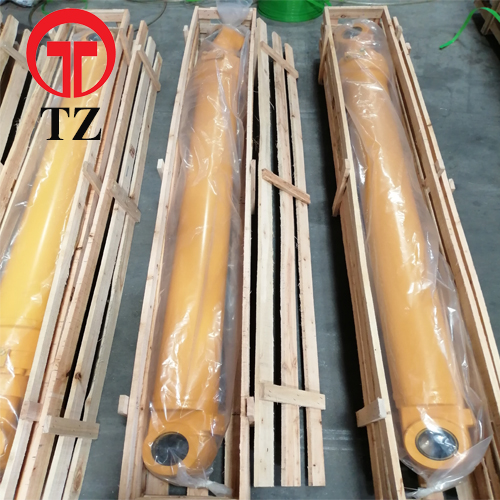Excavators are heavy-duty construction equipment designed to perform a variety of tasks, including digging, excavating, e materiais em movimento. The hydraulic cylinder is a critical component of an excavator, responsible for lifting, lowering, and moving the arm and bucket. When it comes time to replace a hydraulic cylinder, it’s essential to find the right one for your machine.
Types of Excavator Hydraulic Cylinders:

Double-Acting Cylinders:
Double-acting cylinders are the most common type of hydraulic cylinder used in excavators. They are designed to lift and lower the arm and bucket, and are available in various sizes and configurations. Double-acting cylinders have two chambers, one for lifting and one for lowering, which allows for smoother and more precise movement.
Single-Acting Cylinders:
Single-acting cylinders are designed to lift or lower the arm and bucket, but not both. They are typically used in smaller excavators and are available in various sizes. Single-acting cylinders have one chamber, which is either for lifting or lowering, and are simpler in design than double-acting cylinders.
Telescopic Cylinders:
Telescopic cylinders are designed to provide a longer reach for the arm and bucket. They are commonly used in excavators that require a greater lifting height, such as those used in construction and demolition projects. Telescopic cylinders are available in various sizes and are designed to be compact and lightweight.
Hollow Cylinders:
Hollow cylinders are designed to provide a more compact and lightweight design. They are typically used in mini excavators and are available in various sizes. Hollow cylinders have a hollow rod and are designed to provide smoother and more precise movement.
Features Of Excavator Hydraulic Cylinder To Consider:
When selecting an cilindro hidráulico de escavadeira para venda, there are several features to consider. These include:
Tamanho:
The size of the cylinder is critical, as it needs to fit properly in the excavator and provide the necessary lifting and lowering capacity. Cylinders come in various sizes, so it’s essential to choose the right one for your machine.
Lifting Capacity:
The lifting capacity of the cylinder is another critical factor to consider. The cylinder needs to be able to lift the weight of the arm and bucket, as well as any additional loads that may be placed on it.
Stroke Length:
The stroke length refers to the distance the piston travels inside the cylinder. A longer stroke length provides more lifting height, while a shorter stroke length provides more lifting force.
Pressure Rating:
The pressure rating of the cylinder is critical, as it needs to be able to withstand the high pressures generated by the hydraulic system. Look for a cylinder with a high pressure rating to ensure it can handle the demands of your excavator.
Material:
The material used in the construction of the cylinder is also important. Look for a cylinder made from high-quality materials, such as steel or aluminum, to ensure durability and longevity.
Seals:
The seals used in the cylinder are critical, as they prevent leaks and maintain the hydraulic fluid’s integrity. Look for a cylinder with high-quality seals that are designed to last.
Mounting Style:
The mounting style of the cylinder refers to the method used to attach the cylinder to the excavator’s arm or boom. There are several mounting styles available, including:
Pin Mount:
Pin mount cylinders are attached to the excavator’s arm or boom using a pin or bolt. This mounting style is commonly used on smaller excavators and is known for its simplicity and ease of installation.
Bolt Mount:
Bolt mount cylinders are attached to the excavator’s arm or boom using bolts. This mounting style is commonly used on larger excavators and provides a more secure attachment method than pin mount cylinders.
Weld Mount:
Weld mount cylinders are attached to the excavator’s arm or boom using welding. This mounting style is commonly used on heavy-duty excavators and provides a permanent attachment method that is ideal for high-stress applications.
Quick Disconnect Mount:
Quick disconnect mount cylinders are attached to the excavator’s arm or boom using a quick disconnect mechanism. This mounting style is ideal for applications where the cylinder needs to be frequently removed and reattached, such as in maintenance or repair operations.
When selecting a hydraulic cylinder for an excavator, it’s important to consider the mounting style to ensure that it is compatible with the excavator’s arm or boom. Adicionalmente, the mounting style can affect the cylinder’s performance, durability, and maintenance requirements.
Maintenance And Repair Of Hydraulic Cylinders:
Hydraulic cylinders are subject to wear and tear over time, and regular maintenance and repair are necessary to ensure optimal performance and extend the cylinder’s lifespan. When selecting a hydraulic cylinder for an excavator, it’s important to consider the maintenance and repair requirements.
Cylinder Design:
The design of the cylinder can affect its maintenance and repair requirements. Por exemplo, some cylinders may have a more complex design that requires specialized tools or expertise for maintenance and repair.
Materials Used:
The materials used in the construction of the cylinder can also affect its maintenance and repair requirements. Por exemplo, cylinders made from high-quality materials may be more durable and require less maintenance than those made from lower-quality materials.
Seals and Gaskets:
Seals and gaskets are critical components of a hydraulic cylinder, and their quality can affect the cylinder’s performance and lifespan. Look for cylinders with high-quality seals and gaskets that are designed to last.
Lubrication:
Lubrication is essential for the proper functioning of a hydraulic cylinder. Look for cylinders with lubrication ports that make it easy to lubricate the cylinder and ensure its smooth operation.
Pressure Rating:
The pressure rating of the cylinder can also affect its maintenance and repair requirements. Look for cylinders with a high pressure rating that can handle the demands of your excavator.
